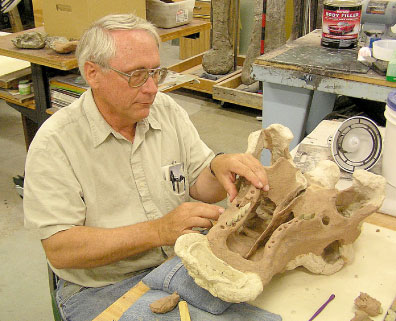Largest nodosaur found
Bragging rights again surround the College of Eastern Utah Museum researchers as they located the largest Nodosaur ever, according to a December 2008 article in the Journal of Vertebrate Paleontology. The nodosaur is an armored dinosaur that is part of the group known as ankylosaurs.

Bragging rights again surround the College of Eastern Utah Museum researchers as they located the largest Nodosaur ever, according to a December 2008 article in the Journal of Vertebrate Paleontology. The nodosaur is an armored dinosaur that is part of the group known as ankylosaurs.
The article, written by Kenneth Carpenter of the Denver Museum of Nature and Science with the assistance of Jeff Bartlett, John Bird and Reese Barrick of the CEU Museum, reports that bones of a partial skull and postcranial skeleton of a new large nodosaurid anklylosaur were found in the Cedar Mountain Formation southeast of Price, Utah.
The quarry has been worked for a number of years by CEU faculty, staff and students and yielded over 1,000 bones. Barrick said the discovery and naming of this creature typifies the timetable common in paleontology in which the bones are discovered, cleaned up, described, compared to other similar skeletons and finally published and named, a process that commonly takes a decade. A skeletal mount for display in the museum is still awaiting completion.
Carpenter used CEU materials and the staff to help with the article, as part of an ongoing partnership with the Denver Museum. Carpenter had previously written a book on all-known armored dinosaurs of the West.
Named Peloroplites cedrimontanus, which translates into the “gigantic monster from Cedar Mountain,” the new dinosaur tops out as the biggest example of a nodosaur ever discovered reaching a length of 18-20 feet and a weight of around four metric tons. CEU’s Nodosaurid is matched only in size by another member of the nodosarid family, Sauropelta, found in the Cloverly Formation of Wyoming and Montana.
According to the article, “The Cedar Mountain Formation has proven to be unusually rich compared with most Cretaceous formations in ankylosaur diversity and in the numbers of specimens recovered.”
The fossil is approximately 115 million years old, or of Aptian-Albian age in geological terms. Interestingly, the dinos were living in a period of global flux and may be part of some extremely interesting ecological-evolutionary response. It’s a fascinating time with some strange trends, Bartlett said.
The article describes the nodoarid as a dinosaur as a gigantic contemporary of similar dinosaurs in the family Ankylosauridae, with interesting features such as large-fused-bony bumps covering its back. With its great size and formidable defenses, an adult Peloroplites would have been nearly invulnerable to predators of its day.
“You have to ask yourself, if you are already built like a tank why would you have to get so big as well!? Even a medium-sized one of this family seems pretty impervious to attack. At some point all that bone is just plain klunky and makes the particulars of one’s life cycle somewhat more difficult to accomplish. It’s interesting to imagine these ponderous creatures and what they were doing from day to day,” Bartlett adds.
The Cedar Mountain Formation of Eastern Utah has produced the greatest diversity of early Cretaceous ankylosaurs in the world, according to the authors of the article.
We see some relevant comparisons with Asia here, with some of their ankylosaurs being later in time. For long the conventional wisdom held that Asia was where the action was, but we are finding more on the North American side across key groups like the armored dinosaurs, Barrick said.
“It is possible that some of the large nodosaurid material from the Cedar Mountain Formation that has been questionably identified as Sauropelta may actually belong to Peloroplites,” Carpenter states.
“That is an interesting conundrum, as part of this puzzle is trying to sort out new material from that already named, and does not imply that previous scholars have it ‘wrong’ but that with new information we can make a new assessment. Lots of new interpretation comes from looking at old materials, and this is one of several projects where previous work is continuing to pay off in terms of identifying new discoveries from sites fifteen years old or more! We don’t hold a candle to some of the European specimens, where some 100-plus year old bones are actually getting new species names. A fun part of paleo is simply using fresh eyes,” Barlett said.




